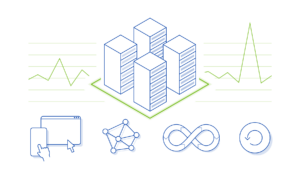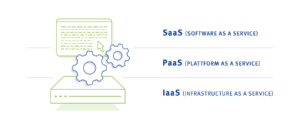IaaS – Infrastructure as a Service simply explained
What is Infrastructure as a Service (IaaS)?
Infrastructure as a Service (IaaS) is a type of cloud computing in which computing infrastructure, including servers, storage, networks, and data center facilities, is provided by an IaaS provider for a rental fee. IaaS is a cost-effective way to cover computing capacity, storage, and network traffic requirements. With IaaS, IT resources can be quickly customized and provisioned without the cost of purchasing and maintaining a physical infrastructure. This makes IaaS a flexible and scalable option for businesses that need to be able to rapidly scale up or down their IT resources as their needs change.
IaaS providers often charge for their services on a pay-as-you-go basis, meaning customers only pay for those resources they use. Infrastructure as a Service can be used to support a variety of workloads, such as for web and mobile applications, big data analytics, software test, and development environments, as well as backup and disaster recovery scenarios.
IaaS can be used as public, private, or hybrid cloud infrastructure.
In a public cloud, all resources are owned and managed exclusively by the service provider.
In the case of a private cloud, all resources are owned and managed by the owner.
In the case of a hybrid cloud, the resources are owned and managed by both the service provider and the customer.

How does IaaS work?
Infrastructure as a Service is a type of cloud computing that gives users access to a virtualized environment. Usually, access is provided via a web-based interface. This allows users to access their virtual machines, storage, and network resources at any time and from anywhere in the world.
What are the advantages of using Infrastructure as a Service?
Probably the most important advantage of IaaS is the flexibility it offers. IaaS is the ideal solution for companies that experience spikes in traffic or need to handle unpredictable amounts of data. Likewise, IaaS frees you from the need to purchase, maintain and upgrade your own physical infrastructure. This can lead to significant cost savings as well as increased efficiency and productivity. Infrastructure as a Service can also be used to implement very sophisticated high availability and disaster recovery concepts. Finally, IaaS can help increase security levels by providing additional layers of security. The sum of these reasons makes IaaS an attractive option for companies of all sizes.
Planning and deciding on IaaS
First, it is essential to evaluate the differences between the various IaaS offerings to know what specific requirements they can be utilized for. Next, determine who will be responsible for managing the IaaS environment. In most cases, it makes sense for the in-house IT team to apply to this task, but there are also managed service providers who can handle the entire operation.
Finally, the use of infrastructure as a service must be planned precisely. This includes deciding which applications and workloads will be outsourced to IaaS, which interfaces to other systems are necessary, and which security levels need to be considered. A well thought-through plan can ensure that IaaS helps the company to achieve greater efficiency and productivity.
The difference between IaaS, PaaS, and SaaS.
IaaS, PaaS, and SaaS are all types of cloud computing, but they offer different levels of service and functionality.
IaaS is the most basic type of cloud computing and includes access to storage, network, and compute resources.
PaaS (Platform as a Service) builds on IaaS and provides a complete development environment too, including programming languages, databases and more.
SaaS (Software as a Service) is the most advanced form of cloud computing and includes access to complete applications, which are fully managed by the service provider.

For which requirements is the use of IaaS valuable?
There are several reasons why companies should consider using IaaS. First, IaaS offers a high degree of flexibility and scalability, which is particularly attractive to companies that need to scale their infrastructure quickly. Moreover, IaaS can be more cost-effective than traditional infrastructures, especially when the necessary staff or expertise to manage a cloud environment is not available. Finally, IaaS can help increase security levels by using additional layers of security. By considering these factors, enterprises can narrow down their options and select the best IaaS provider for their needs.
Disadvantages of IaaS
First, infrastructure as a service may not be as cost-effective as traditional infrastructure in some scenarios. IaaS can also be complex and difficult to manage, especially for organizations unfamiliar with the cloud. Some IaaS providers may have a limited resource pool, which can impact performance. Finally, IaaS requires a certain level of technical expertise to be successfully deployed and managed.
What should be considered when choosing an IaaS provider?
When selecting an Infrastructure as a Service operator, the pricing models, available services, features, and services should be considered. Furthermore, it should be considered how complex it is to set up and manage the resources. Finally, it is also wise to consider the company’s ratings and level of customer service when making the final decision.
Overall, IaaS can be a powerful tool for companies that need quick access to resources with flexible pricing options. However, it is important to understand the pros and cons of IaaS to make an enlightened decision.
Common business scenarios for the use of IaaS
Business continuity: IaaS makes it possible to quickly access additional resources in the event of a disaster or disruption to keep business running without having to invest in setting up, configuring, and managing new hardware.

DevOps: IaaS enables developers to quickly launch virtual machines, configure runtime environments and rapidly deploy applications. These capabilities make it easier for developers to experiment with different technologies, improve collaboration and accelerate the development process.

Hybrid cloud: IaaS provides enterprises with a secure platform to host their applications in the cloud while maintaining an on-premises environment. This hybrid approach makes it possible to take advantage of the scalability and cost-effectiveness of cloud computing while maintaining control of the data in an on-premises environment.

Big-data analytics: With IaaS, organizations can quickly spin up virtual servers for big-data analytics applications with minimal setup and configuration. This makes it easy to use big-data analytics to gain insights into customer behavior and develop personalized products and services.

Backup and recovery: with IaaS, businesses can quickly access and backup their data in the cloud, so they are always prepared in the event of a failure or disaster. This makes it easier for businesses to back up their data while reducing the cost of purchasing, configuring, and managing backups.

High performance computing: IaaS provides businesses with access to high performance computing resources, such as GPUs and CPUs, so they can process intensive tasks very fast. This makes it easier to quickly analyze large data sets or run complex simulations.

Artificial Intelligence (AI): IaaS enables enterprises to easily access powerful AI tools such as machine learning algorithms to use for data analysis and natural language processing.

Containerization: IaaS enables enterprises to quickly launch virtual containers that isolate applications and processes from each other. This makes it easier for developers to instantly test new software and efficiently manage their application deployments.

Security: IaaS provides enterprises with a secure platform to store and process data in the cloud. This enables organizations to protect their data and ensure compliance, while benefiting from the scalability and cost-effectiveness of cloud computing.

Cost savings: Because IaaS provides businesses with an on-demand infrastructure, they can quickly spin it up or tear it down as needed without having to invest in additional hardware or software.

Which tasks must be done on the customer side?
The tasks that need to be done on the customer side can vary depending on the type of which IaaS solution is used. Typically, customers will need to configure their cloud resources and applications, set up user access and security protocols, establish service-level agreements (SLAs) and monitor performance levels. Measures may also need to be taken to update software and ensure data security.
What security criteria should be considered?
Any IaaS provider must ensure that its customers’ data is stored securely, and that only authorized personnel can access it. It is also important that the provider has implemented a comprehensive system of authentication protocols, encryption techniques and monitoring tools to protect customer data. In addition, customers should also consider their security protocols and take steps such as establishing and managing user access and setting data encryption policies.
Taken together, these measures help to further enhance the security of IaaS solutions. Finally, all security practices must be regularly reviewed and updated to ensure that all data is protected from potential threats.